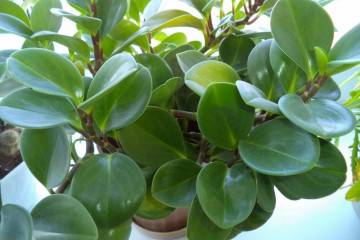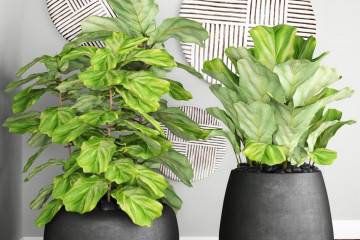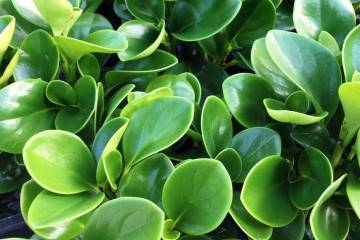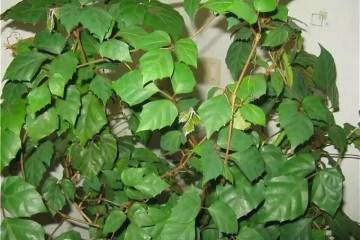Peperomium pilea - home care
Content:
The choice of ornamental plants is striking in its diversity, allowing you to make the desired accent in the design of the living space. A special place is occupied by saws, which differ in many varieties, appearance, and also simple maintenance. One of the brightest representatives of this genus is the peperomium pilea. About how this plant looks and how to care for it at home - below.
Description of the plant
The peperomium pilea is one of the most popular representatives of its genus. Under natural conditions, the Russian climate does not grow. It is grown as an ornamental indoor plant. This plant has gained wide popularity due to the appearance of the leaf plates.
Appearance
Peperomia pilea (Pilea Peperomioides) looks like a small shrub up to 50-55 cm high. The stem is quite fragile, characterized by high growth rates. Its top passes into several shoots, forming a lush crown of a spherical shape.
The leaf blade of the pilea is round and fleshy; it is attached to the stem with a thin long stem. Its surface is glossy with a slight sheen. Young leaves are light green. They darken as they grow. Pale red small flowers are collected in small clusters.
History of appearance
In nature, this plant is found in China and India, preferring fertile soils and mountainous terrain. Pylaea tolerates drought conditions well, but the best condition for its growth is soil saturated with peat.
As a houseplant, the peperomium-like pilea began to be grown relatively recently. It was brought to European countries in the middle of the 20th century. and spread further over time. In everyday life, it is often called the Japanese or Chinese money tree.
Care features
When growing pilea peperomia, home care is quite simple, since the plant is known for its unpretentiousness. To make it feel comfortable, it is enough to create comfortable conditions.
Temperature
The optimum temperature for the growth of pylaea is considered to be the range of 23-26 ° C. However, the peperomium-like sawtooth can grow at 10 ° C, provided that there are no drafts.
Lighting
Pylaea does not tolerate direct sunlight, so the place for its growth should be slightly shaded. Diffused light is the best option, so plant pots are often placed on the west or east side.
In the summer months, you can take flower pots to a loggia or street, where it is also better to choose a not sunny place. In winter, the plant, on the other hand, should receive a sufficient amount of light, since a lack will lead to a change in the color of the leaves.
Watering
In the spring and summer, the saw should be watered as the topsoil dries. It is better to use settled water for irrigation. In winter, the moisturizing procedure is carried out 2-3 days after the top layer of the soil has dried.The plant tolerates drought better than excessive moisture, which negatively affects its decorative appearance.
Spraying
A room saw prefers high humidity, so caring for it is to control this indicator.
Humidity
The peperomian sawtooth prefers high humidity, which can be achieved with modern humidifiers. Also, to increase this indicator, it is recommended to place a container of water near the pot.
Priming
Under natural conditions, the flower prefers to grow on fertile soils, therefore, when growing at home, you should take care of the composition of the soil. It must contain a large amount of nutrients and trace elements. You can stop your choice on ready-made compositions or make a soil mixture yourself. The last option will need the following components:
- 2 parts of humus;
- 2 pieces of leafy land;
- 1 part river sand;
- 1 part peat.
Top dressing
Soil fertilization is required depending on the season:
- in spring and summer, fertilization is done once a week;
- in autumn and winter, the plant should be fertilized no more than 1 time per month.
As a top dressing, complex mineral compositions intended for indoor plants can be used.
Caring for a sawe in winter
This variety tolerates winter well and can grow at air temperatures up to 10 ° C. If such conditions are arranged for the plant, then in the summer it will bloom. Since the flowering of this variety is not valued, then for the winter only watering and feeding are reduced.
Flowering period
In all varieties of pilea, including peperomia, flowering occurs no more than once a year. If abundant flowering occurs in the summer months, then individual flowers in the axillary leaves can appear all year round.
Against the background of variegated leaves, small inflorescences are difficult to notice. The flowers are light pink or creamy.
Since the flowers are of no decorative value, they are often removed. This is done so that the pilea does not waste its energy on flowering.
Pruning
Fast growing varieties require regular formative pruning. Otherwise, the plant will lose its decorative properties and dense spherical crown.
To make the bush lush, it is recommended to pinch its shoots. The procedure should be planned in early spring, before the plant begins to actively grow. Often, pruning is combined with a transplant.
How the pilea reproduces
Propagation of pylaea is possible in two ways: by seeds and cuttings.
Seed method
When propagating by seeds, purchased material is most often used, since it is extremely difficult to achieve their ripening at home. For planting, a flat dish is prepared, which is filled with equal parts of turf, peat and sand.
The seeds are spread evenly over the surface, after which they are moistened with a spray bottle and covered with polyethylene. The best place for germination is a bright and warm room.
The seeds of the peperomium-like pilea germinate unevenly, so the process can take up to two months. All this time, it is recommended to regularly remove the polyethylene, providing the seeds with ventilation. It is completely removed after germination.
Cuttings
The most effective propagation method for the pilea is cuttings. Shoots can be prepared all year round using a branch or stem.The selected part of the plant is cut into segments of 6-7 cm, followed by the stage of their rooting. For this, you can use two compositions:
- a container with water in which an activated carbon tablet was previously dissolved;
- container with soil. The cuttings should be slightly buried in the ground, followed by watering and covering with polyethylene. Such a mini-greenhouse provides the planting material with the necessary temperature and climatic conditions. When the stalk begins to grow, the film can be removed.
After rooting of the shoots and the appearance of several leaves, they are transplanted to a permanent place.
Transfer
The transplant procedure is recommended to be carried out annually. The best time for this is the second half of spring or early summer. Since the pylaea has a small root system, shallow pots 10-12 cm high are suitable for planting it.
Pruning can also be done during transplanting. It consists in shortening the shoots by 30%. If a plant loses its decorative appearance, it is completely rejuvenated.
Possible problems
With improper care, a number of problems can arise:
- drying and falling of leaves. To this result, too low or high temperature in the room can lead;
- spots on the leaves. Contact with direct sunlight may cause burns. At first they look like yellow spots, but over time they take on a brown tint;
- blanching of leaves. An excess of sunlight leads to a lightening of the leaves, and with a lack of them, their darkening is observed;
- wilting leaves. The reason may be stagnant moisture in the soil or excessive watering. Over time, these leaves become almost black and soon fall off.
Pests
At high temperatures and low humidity, the following pests can appear on the plant:
- spider mite. With its defeat, the appearance of a cobweb in the internodes is observed, as well as wilting of the leaf plates. In the early stages of infection, treatment with soapy water will help, and in the later stages - Actellik;
- thrips. You can suspect these pests by the appearance of white dots on the top of the leaf. At the bottom, the insects themselves will be noticeable. In the fight against them, Actellic and Fitoverm preparations are effective;
- shield. When the scabbard is affected, the leaves of the pylaea dry quickly and fall off. Insecticides will also help get rid of the pest.
It is not difficult to take care of the peperomium-shaped saw, therefore it is popular among both experienced florists and beginners. And thanks to its attractive appearance, this plant will adorn any interior.





















